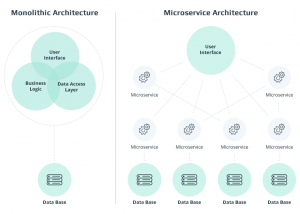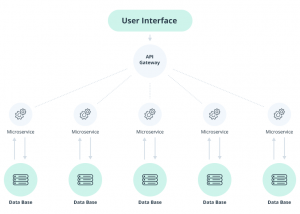Learn how a microservices architecture helps modern businesses stay flexible, quick, and efficient
Being slow and unresponsive to change is every business’s nightmare. Unfortunately, it’s the destiny of many enterprise applications. As soon as they grow an extensive database and accumulate endless lines of code, agility becomes a problem. The large codebase is just impossible to read. Beyond that, adding new features might break the entire system. This results in slow updates and irritated clients. Sound familiar? We bet it does if your application has a monolithic architecture.
By contrast, a microservice application doesn’t cause this trouble. That’s why the microservice architecture has become so popular for software development. Amazon, Netflix, and Uber are just a few of the companies that use a microservices software architecture instead of monolithic architecture. But what are the advantages of microservices for software development? Read on to find out.
What is a microservices architecture?
A microservices architecture (or just microservices) is an architectural style that structures an application as a collection of small independent services. In other words, it allows you to build an application not as a single unit but as a system of loosely coupled scalable applications.
This software development approach is rather new, but it has already become a standard for building continuously deployed systems. Let’s dig deeper into how features of the microservice architecture differ from features of a traditional monolithic architecture.
Advantages of microservices architecture vs monolithic one
A monolithic architecture leads to an application in which all components are closely interconnected. This means the entire system will fail if a single small part fails. But if an application consists of several autonomous parts, it’s much more reliable. Since small services are isolated from each other within a microservices architecture, faults in one service don’t affect the rest of the system. In other words, issues can be fixed without damaging the application’s deployment.
Just imagine how devastating it is to rewrite an entire application when only one section of code needs to be changed. Sadly, that’s what you’ll have to do if your application is monolithic. Adding new features, customizing, fixing bugs — any program updates are painful with a monolithic architecture.
You can say goodbye to innovation and continuous delivery. By contrast, microservices software systems make programs agile and scalable.
The benefits of microservices for your solution
Easy testing, maintenance, and customization. Naturally, small services are less complex than big ones. It’s a lot easier to test and modify separate microservices than it is to test and modify one big application. Also, small services are isolated from each other, so changes in one service don’t affect other services. This means development teams can quickly and easily update applications.
Technological innovation. Since microservices are autonomous, they can be written using different languages and libraries, allowing developers to continuously innovate, use more up-to-date solutions, and pick those that fit a specific task best. Beyond that, a microservices architecture enables easy integration with third-party services. For instance, you can take advantage of platforms such as Amazon Web Services and Google Cloud Services.
Rapid application deployment. Microservices can be deployed independently, so there’s no need to rebuild the entire application at once. Different teams can work on different tasks simultaneously. This speeds up both bug fixing and delivery to market.source database via a secure RESTful API
What are the core elements of a microservices architecture?
The components of microservices software systems are services. Each service has a separate codebase that can be managed and deployed autonomously, runs its own process, manages its own database, and doesn’t expose its internal implementation to others.
Usually, services perform different tasks and are written in different programming languages. In essence, a microservice application is a distributed system running on multiple microservice architecture processes.
How do microservices communicate with each in an application? As a rule, via messages, with the help of an HTTP REST API. The API gateway serves as an intermediary between the UI (clients) and microservices, forwarding user requests to specific services and returning responses from them.
The example microservices architecture
Microservices architecture saves business applications from being immutable
Thanks to their obvious benefits, microservices in software development have become popular. Today, many businesses are choosing to move from monolithic to microservices architecture. And adoption of this new architecture will continue to grow. In fact, the microservice architecture market is projected to reach $32.01 billion by 2023, growing at a CAGR of around 16.17%.
Fast time to market, easy maintenance, and simple integration with third-party services are attractive to business owners. But the most significant advantage of the microservices architecture is that it allows enterprise applications to stay flexible and scalable.
Sadly, large applications are bound to get slow and vulnerable. They risk reaching a point where any changes become time-consuming, costly, and stressful. That’s why more and more businesses are redesigning their monolithic applications into systems of small microservices.
This new architectural style is particularly useful in the FinTech industry. To stay competitive, FinTech companies must be able to manage large databases quickly. Moreover, they have to deal with frequent changes in regulations, licensing policies, and tax structures. Beyond that, their systems have to be as secure as possible. Because everyone knows that a sudden system crash can cost a lot for FinTech companies.
Companies using microservices
Successful migrations to microservices
Luckily, any business application can smoothly evolve from a monolithic to microservices architecture. Take a look at these examples of how Intellias has assisted companies in successfully migrating to microservices and developing a data lake management platform.
Loan comparison platform
One Intellias client is a large online loan comparison platform that connects private borrowers to banks and investors. Intellias started developing the client’s original application more than ten years ago, and it contained three different sub-products in a single codebase. Over time, this monolithic architecture had to be changed to a microservices software system. Intellias performed this transition without taking down the previous code.
Our team started with analyzing the existing codebase and identifying all bounded contexts. Based on this analysis, they rearranged the code and aggregated all functionality related to the back-office sub-product under architectural facades. These new facades were still using old services at the initial stage.
After introducing new facades, the Intellias team started implementing microservices that covered the new business logic. Once a microservice was ready, it went through shadow testing on production.
During shadow testing, the team made double parallel calls to the old service and the new microservice via REST. They compared the results, and when these results met the expectations, the tested facade was transformed into a tiny REST client within the new microservice. Intellias performed these steps iteratively for every new microservice introduced.
In the end, thanks to close collaboration between product owners and Intellias development teams, the platform became maintainable and scalable and achieved superior code quality.
Online sports betting platform
Another Intellias client provides a SaaS platform for iGaming sports betting. But as the product grew, its performance started to decline due to large volumes of data being processed in the cloud. The online platform’s monolithic architecture didn’t allow for quick changes. That’s why our client decided to move this platform to a new flexible microservices software architecture.
Intellias engineers split the core system components into a set of microservices. This new architecture used business function steps based on granularity that allowed for simple scaling. It also offered zero-downtime deployment. Moreover, the development team removed the single points of failure and minimized the number of business functions vulnerable to unexpected system downtime.
In the end, our client received an all-new fully managed sportsbook platform that gives operators access to over 25,000 events per month. The platform went from inflexible and monolithic to a flexible system of microservices. This has extended integration options, allowing for a REST API for S2S integrations and a web client API for customized applications. Most importantly, the platform has high fault tolerance and scalability, which makes introducing new features quick and cost-efficient.
Smart connectivity for consumers
A Fortune 500 company in the consumer goods industry (and an Intellias client) had an old software ecosystem. It consisted of monolithic solutions that were poorly aligned across distinct business processes and domains.
The company went through digital transformation of its services, including modernization of engineering practices, software architecture, and their technology stack. But to complete this transformation, they needed a flexible architecture to cover both internal and consumer needs. Here’s how Intellias helped with the company’s architectural transformation.
The migration to an architecture based on microservices involved development of new interfaces and setting up data streams between applications. The microservices approach was based on an event-driven architecture with message brokers acting as a single source of truth.
The new architecture assured seamless renovation of technology stacks by integrating monolithic legacy applications with custom microservices (Java, Python, Node.js), cloud-native services (AWS RDS, DynamoDB), and serverless functions (AWS Lambda). The critical part of the transformation was establishing DevOps practices and continuous integration and delivery pipelines as well as moving to Amazon Web Services cloud infrastructure.
Together with our client, Intellias achieved excellent results. Our client could build microservices ecosystem and introduced new touchpoints with consumers including IoT connectivity, real-time personalization, and customer care applications.
The redesigned product is a customer engagement platform that offers the client’s headquarters near-real-time data on selling, marketing, and consumption of products in convenient dashboards. Thanks to secure and fault-tolerant AWS solutions, this platform can withstand high loads of data collected from the users around the world. In addition, it can now easily collect and process huge volumes of consumer data to support better product targeting.
As you can see, the use of microservices in software development is an excellent solution for many businesses. It helps large enterprise applications be flexible and scalable — something that’s important for big online services that have to deal with huge amounts of data stored in the cloud.
FinTech companies are the most eager adopters of microservices software systems. The microservices architecture helps them solve problems of monolithic applications, specifically staying fast and responsive to users’ demands. And as successful examples of microservices migration show, the process is easy and painless.
The only challenge is carefully aligning your microservice architecture processes. Putting together diverse services is hard work that needs to be done by a strong microservices development team. So, choose your partners wisely.
Read the original article here. Find out more about Intellias here.










